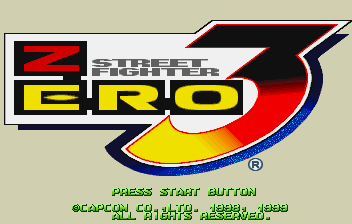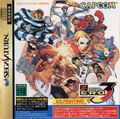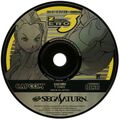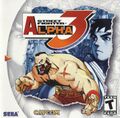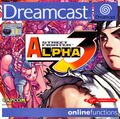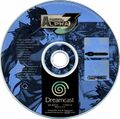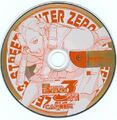Difference between revisions of "Street Fighter Alpha 3"
From Sega Retro
Scarred Sun (talk | contribs) |
|||
| Line 62: | Line 62: | ||
===Dreamcast Version=== | ===Dreamcast Version=== | ||
<gallery> | <gallery> | ||
| − | File:SFA3 DC US Box Front.jpg|US front | + | File:SFA3 DC US Box Front.jpg|US cover (front) |
| − | File:SFA3 DC US Box Back.jpg|US back | + | File:SFA3 DC US Box Back.jpg|US cover (back) |
File:Sfalpha3 dc eu frontcover.jpg|EU cover (front) | File:Sfalpha3 dc eu frontcover.jpg|EU cover (front) | ||
File:Sfalpha3 dc eu backcover.jpg|EU cover (back) | File:Sfalpha3 dc eu backcover.jpg|EU cover (back) | ||
File:Sfalpha3 dc eu disc.jpg|EU disc | File:Sfalpha3 dc eu disc.jpg|EU disc | ||
| + | File:Sfzero3 dc jp frontcover.jpg|JP cover (front) | ||
| + | File:Sfzero3 dc jp backcover.jpg|JP cover (back) | ||
| + | File:Sfzero3 dc jp disc.jpg|JP disc | ||
</gallery> | </gallery> | ||
Revision as of 23:26, 24 June 2010
| Street Fighter Alpha 3 |
|---|
| System(s): Arcade, Sega Saturn, Sega Dreamcast, Playstation, Playstation Portable, Playstation 2, Gameboy Advance |
| Publisher: Capcom |
| Developer: Capcom |
| Genre: Fighting |
Street Fighter Alpha 3, known as Street Fighter Zero 3 (ストリートファイターZERO 3) in Japan and Asia, is a 1998 fighting game by Capcom originally released for the CPS II arcade hardware. It is the third game in the Street Fighter Alpha series, following Street Fighter Alpha: Warriors' Dreams and Street Fighter Alpha 2. The gameplay system from the previous Alpha games was given a complete overhaul with the addition of three selectable fighting styles based on Street Fighter Alpha (A-ism), Street Fighter Alpha 2 (V-ism), and Super Street Fighter II Turbo (X-ism), new stages, a much larger roster of characters, and for the first time since the original Street Fighter II, new theme music for all the returning characters.
Contents
Gameplay
Street Fighter Alpha 3 discards the "Manual" and "Auto" modes from the previous Alpha games by offering the player three different playing styles known as "isms". The standard playing style, A-ism (or Z-ism in Japan), is based on the previous Alpha games, in which the player has a three-level Super Combo gauge with access to several Super Combo moves. X-ism is a simple style based on Super Street Fighter II Turbo, in which the player has a single-level Super Combo gauge and access to a single (but powerful) Super Combo move. The third style, V-ism (or "variable" style), a unique style that allows the player to perform custom combos similar to the ones in Street Fighter Alpha 2. In X-ism, players cannot air-block nor use Alpha Counters. Alpha 3 also introduces a "Guard Power Gauge" which depletes each time the player blocks - if the gauge is completely depleted, then the player will remain vulnerable for an attack.
The controls for several actions has been modified from previous Alpha games. For example, the level of a Super Combo move in A-ism is now determined by the strength of the attack button pressed (i.e Medium Punch or Kick for a Lv. 2 Super Combo), rather than the number of buttons pushed; and throwing is now done by pressing two punch or kick buttons simultaneously.
Saturn Version
A Sega Saturn version of Street Fighter Zero 3 was released in 1999 shortly after the initial Dreamcast version in Japan only. The Saturn port makes use of Capcom's 4-Mega RAM cart and uses all of the features added to the PlayStation version with the exceptions of the polygon usage and the PocketStation mode - that said, the Saturn version uses the extra RAM to include more frames of animation than the PlayStation version. Evil Ryu, Shin Akuma and Guile are immediately selectable. While the World Tour and Survival modes are virtually unchanged from the PlayStation version, Dramatic Battle received major improvements with the addition of Reverse Dramatic Battle and allowing three different characters to be used.
Dreamcast Version
The 1999 Dreamcast version, titled Street Fighter Alpha 3: Saikyo Dojo (or Street Fighter Zero 3: Saikyō-ryū Dōjō in Japan), retains all the added features from the PlayStation version of the game, but features a different World Tour mode. An online mode was added that allowed players to display their high scores. In addition, a Saikyo Dojo mode was added which pits a very weak character of the player's choice against two very strong opponents. This Dreamcast port was re-released in Japan in 2000 as Street Fighter Zero 3: Saikyō-ryū Dōjō for Matching Service, which was released as a mail order title via Dreamcast Direct. The Matching Service version differs from the original due to the addition of an Online Versus Mode.
Naomi Version
Street Fighter Zero 3 was re-released for the arcades in Japan in 2001 under the title of Street Fighter Zero 3 Upper (officially promoted as Street Fighter Zero 3↑). The game was released for the Dreamcast-based NAOMI hardware (rather than the original game's CP System II hardware) and features all the added characters from the console versions of the game. Upper also allows player to upload any customized characters from the Dreamcast version of the game by inserting a VMU into a memory card slot on the cabinet.
Technical Information
ISO Size: 519MB
Number of Players: 1~2
Peripheral(s) Compatibility : Control Pad
External Cartridge Required: 4MB RAM Cartridge
Usage of Memory Backup: Yes
Minimum Memory Required: 84 for each slot
Type of Backup: Game Progress / Config / High Scores
Compatible with VideoCD Card: No
Type of Video Files: Cinepak 1.06
Screenshots
Sega Saturn Version
- Sf3mainmenusaturn.png
Main Menu
- Sf3charselsaturn.png
Character Select
- Sf3fightsaturn.png
Fight Gameplay
